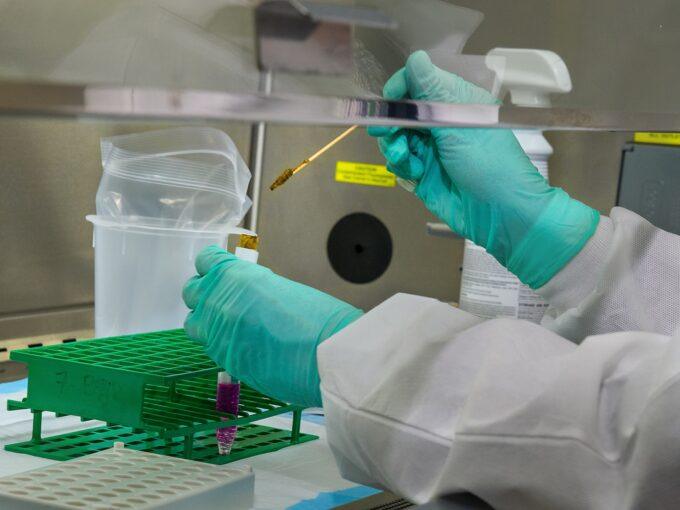
Photo by CDC
These are remarkable times, and they just keep getting more remarkable. The latest is an oped in the Washington Post that actually cites Sanders’ approvingly. The Post ran a pieceby Caleb Watney and Heidi Williams arguing for alternatives to patent monopolies for financing the development of new drugs. The piece approvingly cites a proposal from Sanders from 2013, which would have created innovation prizes to reward drug companies for developing important new drugs.
The context for the mention of Sanders is the concerns raised by the pharmaceutical industry that the lower prices for its drugs, as a result of provisions in the Inflation Reduction Act, will lead them to develop fewer new drugs. Watney and Williams accept that the industry will likely spend somewhat less on research, but make the obvious point that this can be offset by additional government funding for research.
This is an incredibly important point that seems to have largely escaped almost everyone in the debate over limited drug prices. While it is true that if the industry has more money, it will likely invest more in research, there is no reason we have to rely on patent monopolies as the only mechanism for financing research.
As Watney and Williams note, we already rely on the government to support a large amount of biomedical research. While much of this is more basic research supported through the National Institutes of Health, government funding often does support the actual development and testing of new drugs and vaccines, as was the case with the Moderna Covid vaccine developed with funds from Operation Warp Speed. Watney and Williams propose a variety of mechanisms for increased public funding, including something along the lines of Sanders’ innovation prize.
Recognizing the trade-off between patent monopoly supported research and other mechanisms is a huge step forward, but the Watney and Williams piece only gives us part of the picture. Drugs are cheap. The government makes them expensive by issuing patent monopolies and providing other forms of protection.
We will spend roughly $520 billion this year on prescription drugs this year. This is 2.2 percent of GDP or 60 percent of the size of the military budget. If drugs were sold in a free market, without patent monopolies or related protections, we would likely pay less than $100 billion. Drugs that current sell for tens or hundreds of thousands of dollars would likely sell for several hundred dollars. It is rare that drugs are expensive to manufacture and distribute. The high prices stem from the fact that drug companies have a monopoly on a drug that may be necessary for someone’s health or life.
For the extra $400 billion plus that we spend on buying drugs, we get a bit more than $100 billion in research from the pharmaceutical industry. While much of this spending goes to developing important new drugs, much also goes to developing copycat drugs, or innovations that allow drug companies to extend their period of patent protection or other forms of exclusivity in the market.
We can look to replace the patent monopoly financing with other forms of government supported research. We can use routes like the Sanders’ innovation prize, but my preferred route would be the direct funding route, similar to what the National Institutes of Health now pursues with its $50 billion plus budget.
My route would add two additional features. First, it would have the funding go through private companies on long-term contracts, similar to what the Defense Department does with prime contractors on major weapons systems.[1] The other difference would be that I would require that all results be posted as quickly as practical on the web and that all patents would be in the public domain. This means that all new drugs, vaccines, and medical equipment could be sold as cheap generics from the day they are approved by the Food and Drug Administration.
By making all research fully public as quickly as possible, we are likely to see more rapid progress in developing new and better treatments. Researchers could quickly build on successes of other researchers, and avoid taking routes that other researchers had determined to be dead ends.
By having all drugs sell in a free market, as opposed to patent protected prices, we would also avoid much of the corruption resulting from patent monopolies. While all economists recognize that tariffs of 10 or 25 percent can lead to corruption, for some reason they have trouble recognizing that patent monopolies, that raise the price of drugs by 1000 percent or even 10,000 percent above the free market price, can also lead to corruption.
This is especially surprising since the evidence is all around us, starting with the drug pushing that fed the opioid crisis, but with plenty of other prominent examples. When drug companies can sell drugs at prices that are so far above their cost of production, it would be shocking if they didn’t do everything possible to promote their drugs as widely as possible. This is exactly what economics predicts will happen.
Anyhow, moving away from a system of supporting prescription drug research through government-granted patent monopolies to a system of direct public funding will be a long process. But we have to get the debate started. It is great to see the Washington Post taking the first small step on its opinion page.
Notes.
[1] I describe this system in more detail here and in Chapter 5 of Rigged [it’s free].